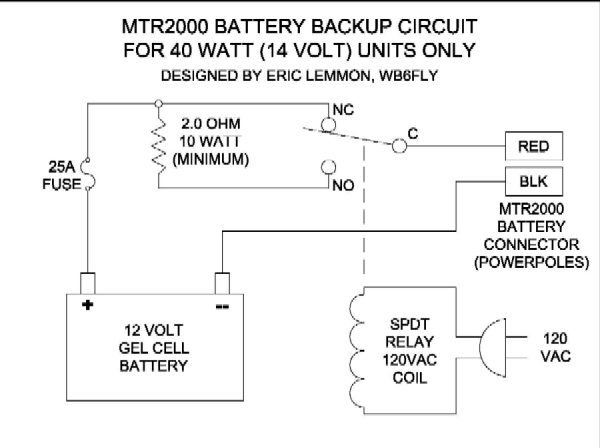Up two levels (Moto index)
Back to Home
of Battery Backup
on an MTR2000 system
This page was developed by Mike Morris WA6ILQ from an email and attachments sent to Repeater-Builder by Eric Lemmon WB6FLY

|
Up one level (MTR index) Up two levels (Moto index) Back to Home |
A Budget Implementation of Battery Backup on an MTR2000 system This page was developed by Mike Morris WA6ILQ from an email and attachments sent to Repeater-Builder by Eric Lemmon WB6FLY |

|
To: Repeater-Builder From: Eric Lemmon WB6FLY Date: 22-April-2007 I have finally gotten around to formalizing my battery backup circuit for the low power VHF or UHF MTR2000 station. It has not been tested on the 100 watt VHF or UHF stations (which require 28 VDC for the PA deck) simply because I didn't have an isolated source of 28 VDC... yet I now have an Astron LS-35M power supply on order from AES, so I'll have the 28 volt design soon. The 250 watt DC power supply that is common to all 30 and 40 watt MTR2000 stations has a dual PowerPole-type of DC input connector at the rear. The connector is normally covered witha metal plate to discourage its use by clueless owners. Since the MTR2000 station is designed to work with the very expensive Argus Battery Reverting Charger, I theorized that it must be okay to connect a battery to this connector without harming any components within the power supply. Sure enough, the schematic reveals that there is an internal Schottky diode for isolation just upstream of the PowerPole connector. All lower-voltage regulators are downstream of the PowerPole connector. So far, so good! Unfortunately, one cannot simply hook a 12 volt battery to the PowerPole connector. The good part is that when an AC power failure occurs, the station will continue to operate on the battery without missing a beat. The station control module senses the loss of AC power and automatically reduces the RF output power to a lower value (which is determined by one of the softpot settings within the RSS). The RSS has an option that causes a periodic beep to be heard over the air when the station is on battery power. This feature is intended to remind the users to be brief. The bad part is that when AC power returns, the station power supply will likely be overloaded when it tries to feed the transmitter while simultaneously the battery is sucking up several amperes of charging current. It will probably go into self-protect mode, and shut itself down. The solution to this problem is very simple: Limit the charging current with a resistor! I determined that the MTR2000 power supply could afford to supply no more than two amperes of charging current if it was simultaneously supplying the power amplifier. Assuming that the MTR2000 will automatically shut down if battery voltage drops to about 10 VDC, I figured that the resistor should be sized to limit current to two amperes when the worst-case disparity was four volts. Ohm's Law says that would be two ohms. Although a maximum of eight watts might be dissipated by this resistor, I wanted to use a heavy-duty power resistor in an aluminum case that could be panel-mounted. It happens that Vishay-Dale makes a type RH-50 resistor in a 2.0 ohm 1% value rated at 50 watts. Mouser Electronics carries this resistor as Catalog Number 71-RH50-2.0, for $4.26 (as of April 2007). Overkill, but not too expensive. Referring to the attached schematic diagram, a heavy-duty relay with a 120 VAC coil rated for continuous duty is used to switch the resistor in and out of the circuit. The relay supply cord should be plugged into the same outlet or circuit as the repeater's power cord. Under normal conditions, the relay is energized, and the battery is float-charged through the current limiting resistor. When AC power fails, the relay de-energizes and connects the battery directly to the station. Works like a champ! 73, Eric Lemmon WB6FLY |
Clicking the schematic below will display a larger image oriented for printing.

Here's the same
circuit modified for the 100w models that use 28 volts.
Note from WA6ILQ:
The relay shown in the diagram has to carry the full operational current of the MTR,
so select a good quality continuous-duty rated relay with appropriately sized (i.e.
20 amp) contacts. Mount the resistor in a location with good airflow.
The MTR2000 has a very versatile internal controller, however if you have yours wired to an external controller (i.e. a Link, Scom, CAT, etc) the repeater controller will have to be powered from the same battery to keep the repeater on the air. An extra pole on the relay could be used to trigger a digital input on the controller to tell it when AC mains power is present. The actual connection of the relay contacts and the programming is dependent on the brand of the controller, but the most common implementation is that when power fails the contacts switch a a digital input pin to ground, and the programming senses that transition and changes the courtesy beep... perhaps from a single "blip" to the morse letter "B". Just educate your users that when the system is in power-fail mode to keep transmissions short to conserve the battery.
Up one level (MTR index)
Up two levels (Moto index)
Back to Home
Original text (the white background and the image) © Copyright 2007 Eric
Lemmon WB6FLY
Hand coded HTML © Copyright 2007 by Mike Morris WA6ILQ
This page created 22-Apr-2007
This web page, this web site, the information presented in and on its pages and in these modifications and conversions is © Copyrighted 1995 and (date of last update) by Kevin Custer W3KKC and multiple originating authors. All Rights Reserved, including that of paper and web publication elsewhere.